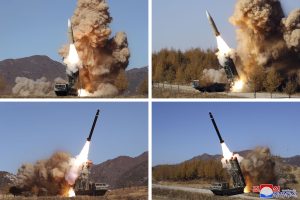On Monday, North Korea’s state-controlled media Korea Central News Agency (KCNA) published a report from the General Staff of the Korean People’s Army (KPA), saying that it conducted corresponding military operations from November 2 to November 5.
According to the report, the military operations referred to the unprecedented missile and artillery shells launches last week in response to Vigilant Storm, the joint military ail drill between South Korea and the United States that ended on Friday.
“The serious situation prevailing on the Korean Peninsula due to the reckless military hysteria of the U.S. and South Korea is now moving toward the more unstable confrontation,” the report said.
North Korea already published statements from a military official and a spokesperson of its Foreign Ministry to warn of its corresponding measures against Vigilant Storm. However, two days after Vigilant Storm ended, it shared more details of what its successive missile launches were all about.
“The large-scale combined air drill is, in fact, an open provocation aimed at intentionally escalating the tension in the region and a dangerous war drill of very high aggressive nature directly targeting the DPRK,” the report said. (DPRK is an acronym of the North’s official name: Democratic People’s Republic of Korea.)
The General Staff of the KPA said that missile units in North Pyongan Province fired “four tactical ballistic missiles loaded with dispersion warheads and underground infiltration warheads” on the morning of November 2. The missiles were targeting “a desert island off the West Sea Barrage,” and this operation was meant to simulate a strike “on the enemy’s air force base.” It also stated that the KPA fired “two strategic cruise missiles” off the coast of South Korea’s Ulsan City from North Hamgyong Province on the same day to respond to the South’s firing of “air-to-surface guided missiles and gliding guided bomb [sic]” into open waters on the North Korean side.
The South Korean military reported on Friday that it detected more than 180 North Korean military aircraft flying in various areas. The general staff of the KPA confirmed the timing but stated that the operation was on a far larger scale than South Korea had reported.
“On the third day of the operations, a large-scale all-out combat sortie operation of the air force with 500 fighters of various missions involved was conducted for 3 hours and 47 minutes in order to show the will to counter the combined air drill of the enemy,” the report said.
The North Korean military claimed that “all the corresponding military operations have successfully achieved the planned purposes.”
“The KPA General Staff once again clarifies that it will continue to correspond to all the anti-DPRK war drills of the enemy with the sustained, resolute and overwhelming practical military measures,” the report said.
According to South Korean media reports, the South’s Joint Chiefs of Staff (JCS) disputed parts of the North’s report over its military activities. In particular, the JCS said it did not detect any cruise missiles launched toward the South’s Ulsan City, despite Pyongyang’s claim. The JCS added that it has not changed its assessment and analysis over the North’s missile launches.
Three days before it published this report, the North’s KCNA also published a statement from a spokesperson for the Foreign Ministry.
The spokesperson also denounced the South Korea-U.S. joint military air drill as “the irresponsible and reckless acts of the U.S. as a grave encroachment upon the security of a sovereign state and a shameless challenge to the international community’s desire for peace and stability in the Korean Peninsula and the region.”
“The U.S. revealed before the world that its stereotyped stand of ‘dialogue without any preconditions’ and ‘setting issues through diplomacy’ is nothing but a smoke screen to deceive the international community and its aim is only to escalate the sustained tension and instability on the Korean Peninsula,” the spokesperson said.
By contrast, he praised North Korea’s warning toward the United States to stop Vigilant Storm “a manifestation of the DPRK’s peace-loving efforts and patience to prevent a dangerous conflict” and to create “a stable security environment” on the Korean Peninsula.
Even though the North has aggressively responded to the joint military drills between its so-called enemies in the region, South Korea is not considering scaling back or halting its military drills with the United States. Seoul’s unification minister previously said that the joint military exercises with the United States are not negotiable.
Since September, the South’s military has conducted military exercises every month. This week, South Korea conducts its annual computer-simulated Taeguk exercise, a four-day command post exercise to hone defensive capabilities against the North’s nuclear and missile threats.
Although Seoul’s exercise scheduled this week is purely defensive, the North may respond to it given Pyongyang’s belligerent stance on the South’s military drills.

































